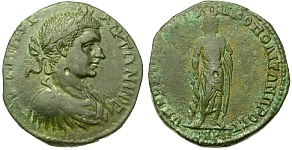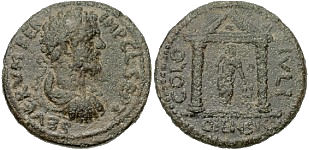Fine Coins Showcase
Antiquities Showcase
Hide empty categories
Shop Search
Shopping Cart
My FORVM
Contact Us
About Forum
Shopping at Forum
Our Guarantee
Payment Options
Shipping Options & Fees
Privacy & Security
Forum Staff
Selling Your Coins
Identifying Your Coin
FAQs
zoom.asp
Home ▸ Catalog ▸ |Themes & Provenance| ▸ |Gods, Non-Olympian| ▸ |Asclepius||View Options:   | | | | | | Asclepius (Asklepios) is the god of medicine and healing in ancient Greek mythology. Asclepius represents the healing aspect of the medical arts, while his daughters Hygieia, Meditrina, Iaso, Aceso, Aglśa, and Panacea (literally, "all-healing") symbolize the forces of cleanliness, medicine, and healing, respectively. |


Asclepius is the god of medicine and healing in ancient Greek mythology. Asclepius represents the healing aspect of the medical arts, while his daughters Hygieia, Meditrina, Iaso, Aceso, Aglaea and Panacea (literally, "all-healing") symbolize the forces of cleanliness, medicine, and healing.SL114186. Silver denarius, RIC IV 251; RSC III 302; BMCRE V p. 451, 103; Hunter III 27; SRCV II 6834, NGC Ch AU, strike 5/5, surface 5/5 (2418735-001), weight 3.02 g, maximum diameter 18 mm, die axis 180o, Rome mint, 215 A.D.; obverse ANTONINVS PIVS AVG GERM, laureate head right; reverse P M TR P XVIII COS IIII P P (high priest, holder of Tribunitian power for 18 years, consul for the 4th time, father of the country), Aesculapius standing slightly right, head left, leaning on snake-entwined staff in right hand, globe at feet on right; from the Craig Chambers Collection, NGC| Lookup; SOLD
Elagabalus, 16 May 218 - 11 March 222 A.D., Nikopolis ad Istrum, Moesia Inferior


Asclepius learned the secrets of healing after seeing one snake bring another herbs. Woman seeking fertility, and the sick and injured, slept in his temples where snakes were left to crawl on the floor and provide healing. Nearby excavations found 2nd c. bronze surgical instruments and a case containing a variety of medicines.RP29741. Bronze AE 26, Varbanov I 3978a, EF, superb portrait, upper reverse flat, weight 11.319 g, maximum diameter 26.1 mm, die axis 180o, Nicopolis ad Istrum (Nikyup, Bulgaria) mint, cos. legate Ti. Flavius Novius Rufus, 218 - 222; obverse AVT K AVPH ANTΩNEINOC, laureate, draped, and cuirassed bust right; reverse YΠ NOBIOY POYΦOY NIKOΠOΛITΩN ΠΠOC ICTPON, Asklepios standing facing, head left, resting right hand on snake-entwined staff, left hand on hip; SOLD
Clodius Albinus, Late 195 or Early 196 - 19 February 197 A.D.


Asklepios was the son of Apollo and a mortal woman named Coronis. Apollo killed Coronis for being unfaithful but rescued the unborn Asklepios from her womb. Apollo carried the baby to the centaur Chiron who raised Asclepius and instructed him in the art of medicine. In return for some kindness, a snake taught him secret knowledge of healing. Asclepius became so proficient as a healer that he surpassed both Chiron and his father, Apollo. Asclepius was even able to evade death and to bring the dead back to life. Zeus killed him to restore balance to the human population but later resurrected Asclepios as a god to prevent a feud with Apollo. Zeus instructed Asclepios to never revive the dead without his approval.SH33951. Silver denarius, RIC IV 2, RSC III 9, BMCRE V 88, SRCV II 6140, EF, weight 3.426 g, maximum diameter 18.8 mm, die axis 180o, Rome mint, as caesar, 193 - 195 A.D.; obverse D CLOD SEPT ALBIN CAES, bare head right; reverse COS II, Asclepius standing left, snake-entwined staff in right hand; SOLD
Hadrianothera, Mysia, c. 130 - 161 A.D.


Hadrianothera was founded by Hadrian to commemorate his successful hunting expedition in the area.RP77196. Bronze AE 19, RPC Online III 1635; SNG BnF 1084; SNGvA 1145 - 1146; BMC Mysia, p. 75, 1; SNG Cop -, Choice VF, some scratches and bumps, areas of porosity, weight 4.377 g, maximum diameter 19.4 mm, die axis 0o, Hadrianothera (near Dursunbey, Turkey) mint, pseudo-autonomous, c. 130 - 161 A.D.; obverse IEPA CYNKΛHTOCC, draped youthful bust of the senate right; reverse AΔPIANOΘHPITΩN, Asklepios standing facing, head left, himation around waist and legs and over left shoulder, leaning on snake entwined staff in right hand, monogram lower right; rare; SOLD
Caracalla, 28 January 198 - 8 April 217 A.D.


RIC only lists the variants where Aesculapius is looking left, however market evidence shows a good number of dies have the god facing as on our coin.RS12109. Silver denarius, RIC IV 253 var., Choice MS, weight 3.305 g, maximum diameter 20.3 mm, die axis 0o, Rome mint, 215 A.D.; obverse ANTONINVS PIVS AVG GERM, laureate head right; reverse P M TR P XVIII COS IIII P P (high priest, holder of Tribunitian power for 18 years, consul for the 4th time, father of the country), Asclepius standing facing, snake-entwined staff in right hand, Telesphorus at feet on left, globe at feet on right; lustrous, full circle centering; SOLD
Clodius Albinus, Late 195 or Early 196 - 19 February 197 A.D.


Asklepios was the son of Apollo and a mortal woman named Coronis. Apollo killed Coronis for being unfaithful but rescued the unborn Asklepios from her womb. Apollo carried the baby to the centaur Chiron who raised Asclepius and instructed him in the art of medicine. In return for some kindness, a snake taught him secret knowledge of healing. Asclepius became so proficient as a healer that he surpassed both Chiron and his father, Apollo. Asclepius was even able to evade death and to bring the dead back to life. Zeus killed him to restore balance to the human population but later resurrected Asclepios as a god to prevent a feud with Apollo. Zeus instructed Asclepios to never revive the dead without his approval.SH33339. Silver denarius, RIC IV 2, RSC III 9, BMCRE V 88, Hunter III 3, SRCV II 6140, gVF, strong portrait, reverse a little weak, weight 3.109 g, maximum diameter 17.7 mm, die axis 0o, Rome mint, as caesar, 193 - 195 A.D.; obverse D CLOD SEPT ALBIN CAES, bare head right; reverse COS II, Asclepius standing left, snake-entwined staff in right; SOLD
Rhegion, Bruttium, Italy, c. 215 - 150 B.C.


Rhegion reached great artistic and cultural heights. It was home to academies, such as the Pythagorean School, and to poets, historians and sculptors such as Ibycus, Ippy, and Pythagoras. It was an important ally of the Roman Republic. Rhegium flourished during the Imperial Age but was devastated by several major earthquakes and tsunami. St. Paul passed through Rhegium on his final voyage to Rome.GB31124. Bronze pentonkion, HN Italy 2551; SNG ANS 745 ff.; BMC Italy p. 382, 94, aVF, weight 10.007 g, maximum diameter 24.6 mm, die axis 270o, Rhegion mint, c. 215 - 150 B.C.; obverse janiform female head, wearing polos; reverse Asklepios seated left, long scepter vertical before him in right hand, Π left, PHIΓINΩN downward on right; SOLD
Trikka, Thessaly, Greece, c. 400 - 344 B.C.


Trikka, modern Tikala, is located in the fertile plain of Thessaly in central Greece. Trikka was the birthplace of three of the Argonauts and also claimed to be the birthplace of Asklepios. Epidaurus also claimed to be the birthplace of Asklepios and that city was the site of his main temple in antiquity.GB86191. Bronze trichalkon, BCD Thessaly II 788; SNG Cop 266; BMC Thessaly p. 52, 17; Liampi Trikka 7; Rogers 556; Moustaka 181, gVF, attractive style,, weight 7.245 g, maximum diameter 20.9 mm, die axis 180o, Thessaly, Trikka (Tikala, Greece) mint, c. 400 - 344 B.C.; obverse head of the Nymph Trikka right, wearing triple-drop pendant earring; reverse Asklepios seated right on a stool, bearded, nude to the waist, himation around hips and legs, transverse staff on far side leaning on left arm, feeding bird held in his right hand to snake coiled and rising up before him; rare; SOLD
Septimius Severus, 9 April 193 - 4 February 211 A.D., Dium, Macedonia


Dium in Macedonia did not strike coins until it received a Roman colony. Coins were struck with Latin inscriptions abbreviating Colonia Julia Augusta Diensis Decreto Decurionm. GB83072. Bronze AE 25, Varbanov 3444, BMC Macedonia -; SNG Cop -; SNG ANS -; Lindgren -; AMNG III -, VF, weight 7.311 g, maximum diameter 25.2 mm, die axis 225o, Macedonia, Dium mint, 9 Apr 193 - 4 Feb 211 A.D.; obverse IMP C L SEPT SEVERVM PER, laureate, draped, and cuirassed bust right, seen from behind; reverse COLO IVLI DIENSIS, distyle temple, Asklepios standing facing within, leaning on serpent entwined staff in his left, D - D flanking him; scarce; SOLD
Valerian I, October 253 - c. June 260 A.D., Cotiaeum, Phrygia


Asklepios is the Greek god of medicine. Hygieia is the goddess of health and Asklepios' daughter. Telesphoros is Asklepios' assistant. Asclepius learned the secrets of keeping death at bay after observing one snake bringing another snake healing herbs. Woman seeking fertility, the sick, and the injured slept in his temples in chambers where non-poisonous snakes were left to crawl on the floor and provide healing.RP91190. Bronze tetrassarion, SNG Munchen 333; SNGvA 3791; SNG Hunterian 2048; BMC Phrygia p. 177, 95 var. (exergue in two lines...Ω/N); SNG Cop -; SNG Righetti -, Choice VF, well centered, dark patina, highest points flatly struck, small edge split, central depressions, weight 6.308 g, maximum diameter 25.2 mm, die axis 180o, Cotiaeum (Kutahya, Turkey) mint, Oct 253 - c. Jun 260 A.D.; obverse AYT K Π ΛIK OYAΛEPIANON, radiate, draped, and cuirassed bust right, seen from behind; reverse EΠI Π AI ΔHMHTPIANOY IΠΠ (P. Ailios Demetrios, archon and hipparchos), Hygieia, on left, standing right, feeding serpent in right hand from patera in left hand; Asklepios, on right, standing facing, head left, leaning with right hand on serpent-entwined staff; Telesphoros between them, standing facing, ΛP/X in two lines above center, KOTIAEΩN in exergue; SOLD

You are viewing a SOLD items page.
Click here to return to the page with AVAILABLE items.
The sale price for a sold item is the private information of the buyer and will not be provided.



Page created in 1.312 seconds.






